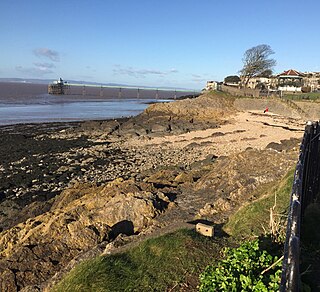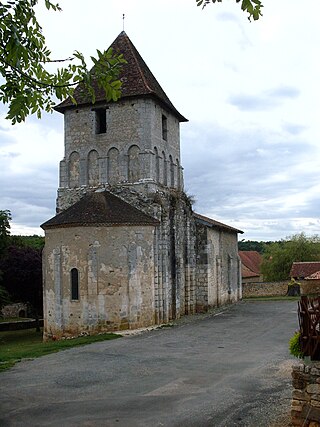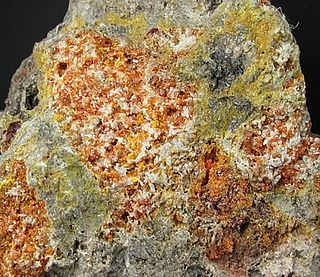
Sphalerite is a sulfide mineral with the chemical formula (Zn,Fe)S. It is the most important ore of zinc. Sphalerite is found in a variety of deposit types, but it is primarily in sedimentary exhalative, Mississippi-Valley type, and volcanogenic massive sulfide deposits. It is found in association with galena, chalcopyrite, pyrite, calcite, dolomite, quartz, rhodochrosite, and fluorite.

Galena, also called lead glance, is the natural mineral form of lead(II) sulfide (PbS). It is the most important ore of lead and an important source of silver.

The mineral marcasite, sometimes called "white iron pyrite", is iron sulfide (FeS2) with orthorhombic crystal structure. It is physically and crystallographically distinct from pyrite, which is iron sulfide with cubic crystal structure. Both structures contain the disulfide S22− ion, having a short bonding distance between the sulfur atoms. The structures differ in how these di-anions are arranged around the Fe2+ cations. Marcasite is lighter and more brittle than pyrite. Specimens of marcasite often crumble and break up due to the unstable crystal structure.

The Southeast Missouri Lead District, commonly called the Lead Belt, is a lead mining district in the southeastern part of Missouri. Counties in the Lead Belt include Saint Francois, Crawford, Dent, Iron, Madison, Reynolds, and Washington. This mining district is the most important and critical lead producer in the United States.

Clevedon Shore is a 0.38 hectare geological Site of Special Scientific Interest adjacent to the Severn Estuary at Clevedon, North Somerset, notified in 1991.
U.S. Silver & Gold Inc. was a mining company based in Wallace, Idaho near Coeur d'Alene, Idaho. The chairman of the company was Bobby E. Cooper, the CEO was Tom Parker.

Saint-Martin-le-Pin is a commune in the Dordogne department in Nouvelle-Aquitaine in southwestern France. It is part of the Regional Natural Park Périgord Limousin.
Silver mining in Colorado has taken place since the 1860s. In the past, Colorado called itself the Silver State.

Carbonate-hosted lead-zinc ore deposits are important and highly valuable concentrations of lead and zinc sulfide ores hosted within carbonate formations and which share a common genetic origin.
Silver mining in Nevada, a state of the United States, began in 1858 with the discovery of the Comstock Lode, the first major silver-mining district in the United States. Nevada calls itself the "Silver State." Nevada is the nation's second-largest producer of silver, after Alaska. In 2014 Nevada produced 10.93 million troy ounces of silver, of which 6.74 million ounces were as a byproduct of the mining of gold. The largest byproducers were the Hycroft Mine, the Phoenix Mine, the Midas Mine and Round Mountain.

The Broken Hill Ore Deposit is located underneath Broken Hill in western New South Wales, Australia, and is the namesake for the town. It is arguably the world's richest and largest zinc-lead ore deposit.

Saint-Pardoux-la-Rivière is a commune in the Dordogne department in Nouvelle-Aquitaine in southwestern France. It forms part of the Parc naturel régional Périgord Limousin.

The Leadville mining district, located in the Colorado Mineral Belt, was the most productive silver-mining district in the state of Colorado and hosts one of the largest lead-zinc-silver deposits in the world. Oro City, an early Colorado gold placer mining town located about a mile east of Leadville in California Gulch, was the location to one of the richest placer gold strikes in Colorado, with estimated gold production of 120,000–150,000 ozt, worth $2.5 to $3 million at the then-price of $20.67 per troy ounce.
The Neuil Mine, in French Mine de Neuil, is a mine emplaced in paragneisses of the northwestern Massif Central. The mine is part of the commune of Saint-Pardoux-la-Rivière in the Dordogne. Extracted from the mine was galena, slightly enriched in silver.

Hemihedrite is a rare lead zinc chromate silicate mineral with formula Pb10Zn(CrO4)6(SiO4)2(F,OH)2. It forms a series with the copper analogue iranite.

Rampgill mine is a disused lead mine at Nenthead, Alston Moor, Cumbria, England UK Grid Reference: NY78184351

Teineite is a tellurite mineral with the formula Cu(TeO3). 2 H2O. It has a Mohs hardness of 2.5 and it comes in many different shades of blue, ranging from cerulean blue to bluish-gray. The mineral millsite has the same chemical composition, but crystallizes in the monoclinic system, while teineite crystallizes in the orthorhombic system.

The Société des mines et fonderies de Pontgibaud was a French silver and lead mining and smelting company based in Pontgibaud, Puy-de-Dôme. It mined lead-silver ore deposits that had been exploited since Roman times. Later it opened another factory in Couëron in the Loire estuary, and then closed down the Pontgibaud mines and foundry. The Pontgibaud factory in Couëron diversified into other non-ferrous metal products using imported ore. After being sold and resold it finally closed in 1988.